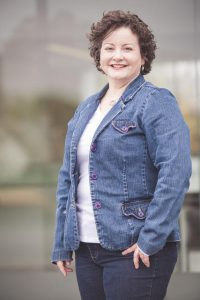 Tamara Copple’s pathway to her career today as a Business Analyst at New Directions Behavioral Health took many twists and turns along the way – but the foundation for her passion toward technology found its roots back in her undergraduate studies in interior design, when she truly wished she were studying architecture instead.
Tamara Copple’s pathway to her career today as a Business Analyst at New Directions Behavioral Health took many twists and turns along the way – but the foundation for her passion toward technology found its roots back in her undergraduate studies in interior design, when she truly wished she were studying architecture instead.
Copple began her freshman year of college in 1990, and residential architecture served as her true passion at the time. She aspired to study architecture, “but architecture was for boys,” she said. “Girls did interior design. I think I’m probably at the tail end of a generation that felt that way.”
Back then, Copple said, she lacked the self-confidence and the support “to be whatever she wanted to be.” Her interior design-focused studies were not her true passion and calling. “I kept trying to find that next challenge. I knew that I hadn’t hit my peak yet.”
By 2002, Copple was working as a junior business analyst, and later spent more than 10 years in client relations management before returning to a business analyst role in June 2016. Today, at New Directions Behavioral Health, Copple she works on the database side, and she designs software improvements to the database so that the processes to the end user move more smoothly.
She credits her attendance at an early Coding & Cocktails session in April 2015 as the push that really helped her seriously consider a career as a computer programmer. She now serves on the Kansas City Women in Technology Board of Directors, and she is co-director of Coding & Cocktails.
Copple’s top hobbies include Dungeons & Dragons and cross-stitch. She also is continuing her computer programming education through LaunchCode in Kansas City.
How did your interest in coding begin?
I started as a junior business analyst at DST in 2002, right after I got my master’s degree. I left the junior business analyst area so I could learn more about the company and its products. I did a lot of client relations work for a long time. After a while, I realized I wanted to get back into software development, and it was about the right change in my career. My husband is a software developer, and he always encouraged me to get back into it because he said I had the skills to do it. He was always supportive; it was Coding & Cocktails and the enthusiasm that was there that really pushed me. I was actually one of the very first participants in Coding & Cocktails back in 2015. It was enough to really get me hooked.
How has your technical knowledge transferred into other aspects of your life?
When we first got married, my parents knew that my husband was the techie in the family, so they called him. When I got deeply involved in Coding & Cocktails, my parents then started calling me and Matthew was completely happy to turn over that role. Also, it helps me be taken seriously when I go someplace and I ask technical questions.
What do you enjoy most about your work?
The databases are composed of little bits of information, and altogether, you can tell a story with that information and you can tell whatever story needs to be told. I really enjoy letting the data telling its story. I also really enjoy the team that I am working with – they are really smart, and they are easy to get along with. It’s a joy getting to go to work and I look forward to it every day.
What are the more challenging aspects of your career?
I am not patient person, and I never have been. I think in concepts and big ideas and broad brush strokes. Learning to pay attention to the details is a real learned behavior for me. That phrase “attention to detail” made me want to cringe most of my life.
What advice would you offer your younger self today, or to someone who is looking to shift careers into one more coding-based?
No matter how long it takes, the journey of self-discovery is worth it. You don’t know where the end is until you find it. All they were, for me, were bumpers – they were guard rails to tell me what direction I should be going.
If you could tell the general public one thing about software engineers and what it means to write code, what would it be?
The human brain can analyze a thousand variables and make a split-second decision about how to react, like when you are in a car accident or trying to catch something falling off of a table. The act of trying to do that same thing but teach a computer how to do is where the magic happens.
How do you envision STEM evolving into our daily lives?
Technology is already as much of a part of us as breathing. We cannot live without our computers, our phones, our electricity, our vaccines – can’t live without it. The real question is about how to use technology in the right way. I’m a big proponent of knowing when the technology should end and how to commit learning to memory. My ideal world is one in which we have balanced the technology, and it gives us a comfortable living, but we don’t forget about where we came from.
-Adrianne DeWeese
Leave a Reply